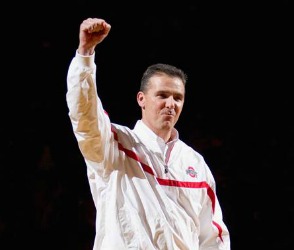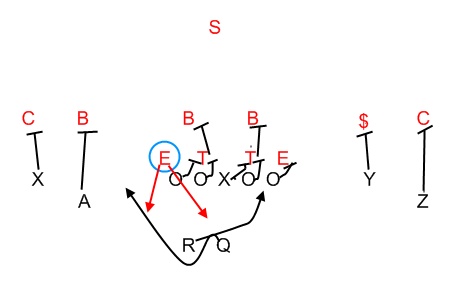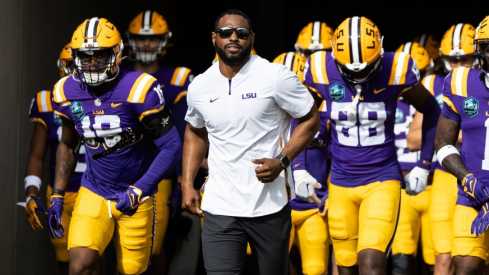 Fist pump for math.
Fist pump for math.We are beyond excited to announce the addition of Ross Fulton to Team 11W. Finally, your favorite Buckeye site has the preeminent Xs and Os guy this side of Chris Brown and he'll be delivering the goods on a regular basis1. Please welcome Ross to the fold and take this opportunity to soak up the benefits of spread arithmetic. You can follow Ross on twitter @RossRFulton.
This winter, I took a two part look at the Urban Meyer offense, namely his philosophy and base plays (See here and here). I now want to take a step back to a more foundational question--why does an offense choose to spread? As Ohio State's offense will now primarily base from "spread" formations going forward, it is helpful to understand why they are doing so.
First, a definitional point. As I discuss here, the terms 'spread' has been over-applied to have lost any meaning, used for offenses as diverse as Mike Leach's airraid to Rich Rodriguez's zone read. For my purposes, I will define spread as any offense that is based out of shotgun to run the football.
The definition itself somewhat belies the answer to my question. The short answer to why a team wants their quarterback in the shotgun is arithmetic. As Chris Brown of Smart Football succinctly describes, both the offense and defense have eleven players. The defense will always outnumber the offense, however, because the defense has a counterpart to the offense's ball carrier, and thus an unblocked defender.
A pro-style offense handles this by using the passing game as a threat. That unblocked defender generally has to play deep as a free safety to defend against the pass. However, from a pro-style system, once the quarterback hands off the defense now has two unblocked players, because the quarterback becomes a spectator, leaving the defense's counterpart to the running back and quarterback both free. As a result, the defense not only has an unblocked free safety, but also a defender closer to the line of scrimmage, generally in the form of the unblocked edge player away from the called run.
The most basic way a pro-style offense deals with this problem is to bootleg off run action to hold the backside defender (though Jim Tressel-era offenses often failed to execute these 'constraint' plays). As Chris Brown observes, though, this is an imperfect option, namely because it must be determined pre-snap, and turns the quarterback's eyes away from the action.
The 'spread' attacks this problem by putting in the shotgun and making him a run threat. This began with the basic zone read. Suddenly, the defense must account for an additional run threat, taking up the tenth defender. (H/T: Smart Football). Now, the quarterback's counterpart is held by the read, causing him to hold his gap rather than crash down, as in the clip above.

Note that the primary purpose is to hold that defender to open up your base run play. So a spread team may run the same zone play as an offense under center, but the spread team negates an unblocked defender with the read and threat of the QB run. Of course, if the end does cheat, then the quarterback will pull the ball to gain yardage.
The arithmetic advantage works beyond simply opening up base tailback runs. When the offense makes the quarterback a potential ball carrier, the defense again loses one of the unblocked defenders. The offense can do this in two ways. It can run true option, such as inverted veer, which takes advantage of what option offenses have long known, which is that the best way to 'block' an unblocked defender is to option him.
The second is to use the quarterback as the ball carrier on designed runs. Now the offense has ten blockers for ten defenders, while running the same base run plays.
The spread's entire premise, then, is by making the quarterback a run threat, an offense gains an arithmetic advantage without devoting an entire offense to option football. Note that my discussion had nothing to do with spreading out receivers. That is simply an add-on advantage where, because the quarterback can run the football, an offense can remove people from the box and still have an effective run game.
Where and how an offense spreads its skill players is thus an added bonus, used to gain leverage and force defensive looks. The core of the offense is the quarterback as run threat and what it does to the arithmetic of football. This is the base of Urban Meyer's offense--to gain a numbers' advantage to run the football inside. As we move forward this offseason, I will continue to examine the foundational aspects of Urban Meyer's 'spread' system.
- 1 No, but seriously, do you know how much it took to get Ross? His contract calls for 20 pounds of Kobe (no skimping with Wagyu, either) beef, two pounds of prime Italian truffles and three large bags of Peanut M&Ms per week. And poor Corey has to sort out all of the brown M&Ms by hand before we deliver them to Ross. Won't you please consider contributing to our fundraiser? This is just the start in a whole series of awesome things we have planned for the next year and your help will go a long way towards helping us achieve these goals.

